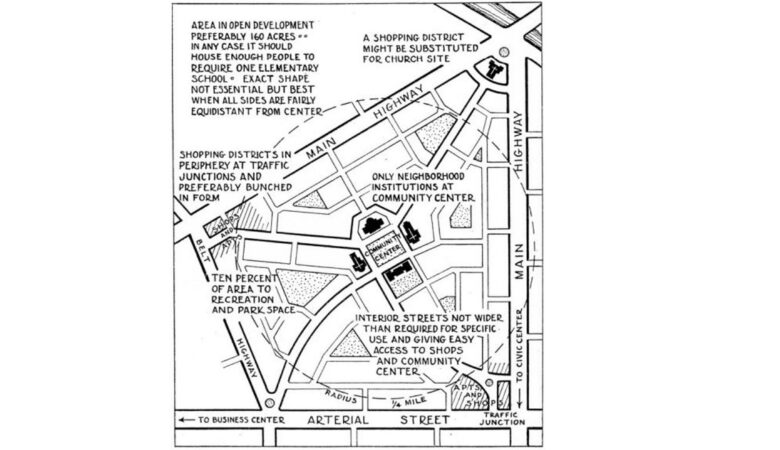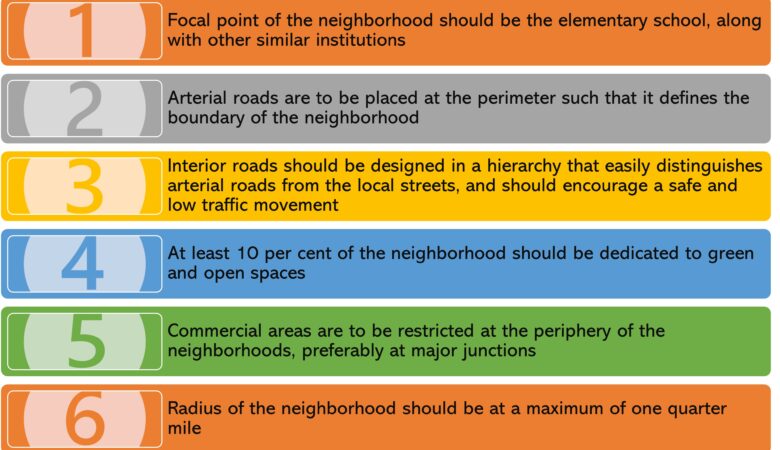Background
The concept of neighborhood has been used by planners since the beginning of time, but it is only recently that we have begun to understand its meaning and implications for urban design and planning. The term “neighborhood” was first introduced into American city planning literature in the early 1900s as part of the movement toward comprehensive planning. According to (Whittick, 1974), a neighborhood is an urban area related to a larger community of which it is a part and consists of residential districts, shopping facilities, open spaces, schools, religious building, etc.
Soon, the concept of neighborhood unit emerged as a planning concept in response to the degenerate environmental and social conditions that fostered as a result of industrial revolution in the early 1900s. In the United States, neighborhood units were originally conceived as small areas within which all residents had access to basic services such as schools, parks, stores, etc., and where they could live without having to travel long distances. As a result, they are often defined by their proximity to public transportation or other amenities. Charles Arthur Perry, an architect and planner from New York, was one of the first authors that defined the concept of ‘neighborhood unit’.
Conception of neighborhood unit
The origin of the neighborhood unit as a concept can be traced back to the 19th century when many scholars were concerned about the quality of life in the city. However, the publication of Clarence A. Perry’s memorandum entitled ‘The Neighborhood Unit’ in 1929 led to its promotion as a comprehensive planning tool. It was to be utilized as a self-containing residential area that promoted a community-centric lifestyle, which was away from all the hustle and bustle of the city especially during the industrializing New York City in the early 1900s.
Perry defined a neighborhood as a collection of dwelling units located close together, having a common interest in the character of the surrounding areas. He also stated that a neighborhood is a small-scale community where people know each other, share many of their activities, and provided a sense of belonging.
Later in his book titled ‘Neighborhood Planning’, Perry (1953) emphasized the importance of the physical environment in creating a sense of community. He believed that the quality of life depends on the type of housing, streets, sidewalks, trees, lighting, etc. He argued that if these elements are not properly designed, then the quality of life would be poor. Therefore, he suggested that the planning of neighborhoods should be based on the needs of the people who live there, and thereby encourage social interaction and cohesion among residents living in the defined neighborhood.
Description of Perry’s Neighborhood Unit
According to Perry, a neighborhood should comprise a population of about 5000–9000 residents, with schools, places of worship, and recreational areas at its center. The 160-acre neighborhood is to be developed such that there are 10 dwellings per acre. This would also require an elementary school with an enrolment of between 1,000 and 1,200 pupils. The design should allow the residents to access basic facilities and services at a distance of not more than one-quarter mile from their place of residence.
Further, about 10 percent of the area is to be allocated to recreation. The arteries of the roads are confined to the surrounding streets, and the internal streets are limited for access to the residents of the neighborhood.
Figure: Clarence Perry’s neighborhood unit

Six principles of a good neighborhood unit
In addition to the above-mentioned characteristics of a neighborhood, Perry outlined six principles that should guide the design and development of a good neighborhood:

Criticisms of Perry’s neighborhood concept
Perry’s neighborhood unit theory was used widely for the basic planning of cities and residents around communities. The concept has, however, been criticized from a range of perspectives. Some planners and urbanists criticized it for being too restrictive in terms of land use. In fact, many countries have adopted policies that promote mixed-use developments, which include residential, commercial, and industrial uses within close proximity. Some also believe the concept is centralized around the city’s urban areas and cannot be applied to the rural areas. Others argue that the concept of neighborhood unit does not take into account the diversity of cultures and lifestyles across different regions. Hence, the concept of neighborhood units cannot be applied uniformly across all parts of the world.
Perry’s concept has also been criticized as a device of social segregation by many and has argued that the neighborhood unit is a tool to segregate society into homogeneous groups. However, others argue that the concept of the neighborhood unit can help reduce the level of poverty and inequality in the society.
Conclusion
Despite the various criticisms, the concept of neighborhood units is still relevant today because it provides a framework for the planning of cities and towns. It helps in the creation of livable communities where people live together and interact with each other. The concept of neighborhood unit has been institutionalized in various cities across countries including New York City, Chicago, Los Angeles, San Francisco, Tokyo, and India.
References:
- Lawhon, L.L. (2014). Neighborhood Unit. In: Michalos, A.C. (eds) Encyclopedia of Quality of Life and Well-Being Research. Springer, Dordrecht. https://doi.org/10.1007/978-94-007-0753-5_3335
- Nahyang Byun, Youngjun Choi & Jaepil Choi. (2014). The Neighborhood Unit: Effective or Obsolete?Journal of Asian Architecture and Building Engineering, 13:3, 617-624, DOI: 10.3130/jaabe.13.617
- Meenakshi. (2011). Neighborhood Unit and its Conceptualization in the Contemporary Urban Context. [online] Itpi.org.in. Available at: <http://www.itpi.org.in/files/jul10_11.pdf> [Accessed 30 July 2022].
Also Read: